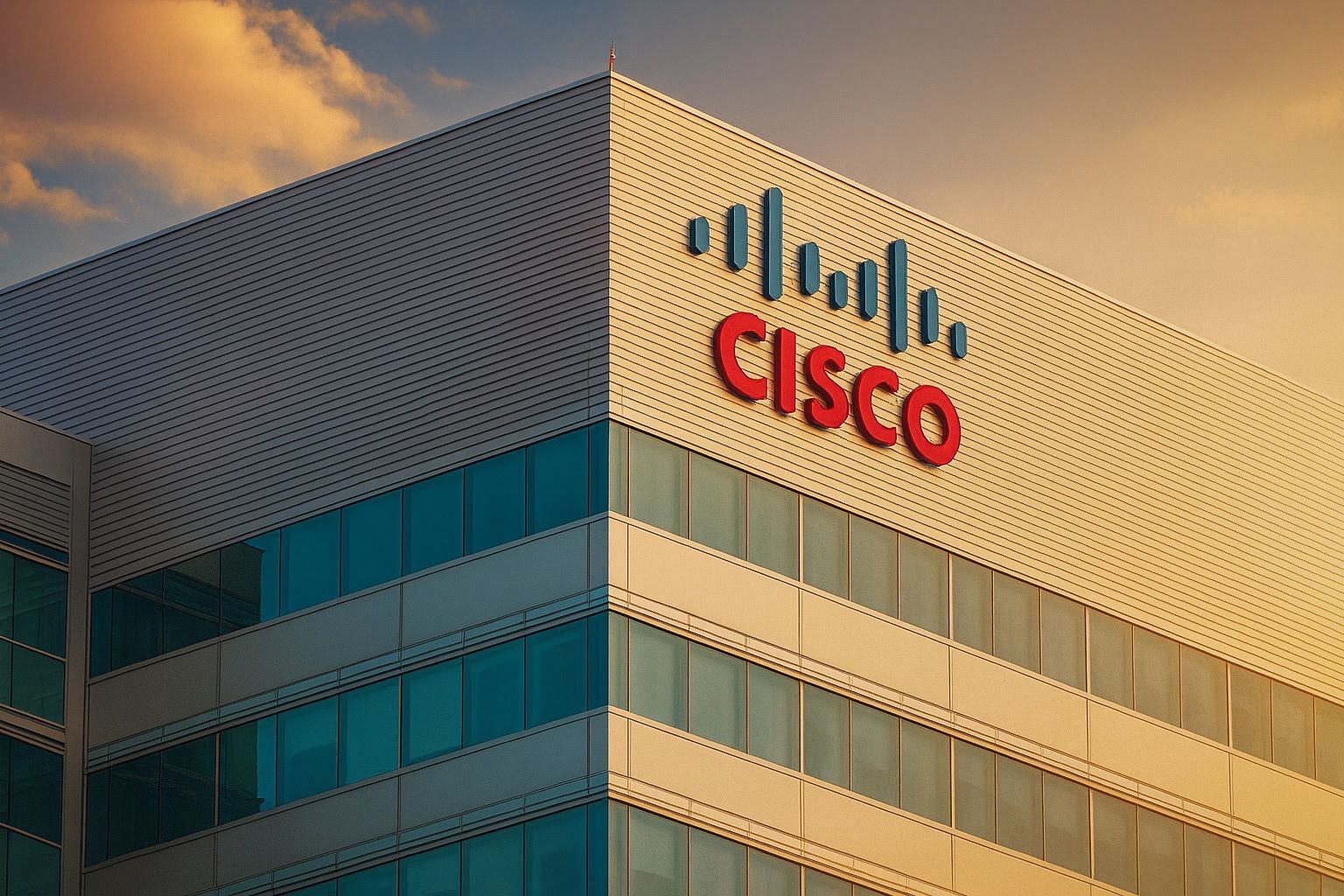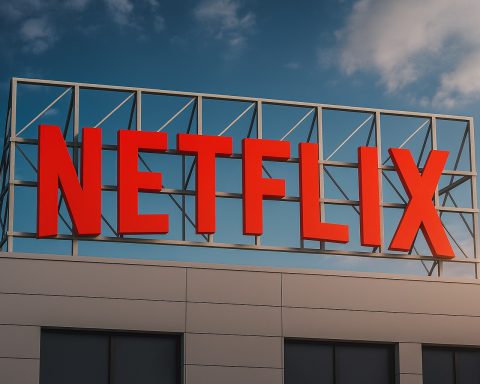Cisco is trading just below multi‑decade highs after a powerful AI‑driven earnings rally. Here’s what matters for CSCO as Wall Street heads into Friday’s session.
Quick takeaways for busy readers
- CSCO is coming into Friday near $77–78, up sharply from earlier in the week and sitting close to its 12‑month high around $79.50 after a post‑earnings surge. [1]
- Fiscal Q1 2026 results beat expectations on both revenue and earnings, helped by strong AI networking demand and the integration of Splunk. [2]
- AI infrastructure orders from hyperscalers are accelerating fast – Cisco booked about $1.3 billion in AI orders in the quarter and now expects roughly $3 billion in AI infrastructure revenue in fiscal 2026. [3]
- Wall Street has rushed to raise price targets (many now in the $82–$100 range); the stock carries a “Moderate Buy” consensus with an average target around $82. [4]
- New AI moves – the NeuralFabric acquisition and the Unified Edge Platform – deepen Cisco’s push into enterprise AI and edge computing, while fresh critical security patches for Unified CCX remain a risk factor to monitor. [5]
Below is a deeper look at what traders and longer‑term investors may want to watch in CSCO today.
1. Where Cisco stock stands after Thursday’s surge
Cisco enters Friday’s session on the back of a big earnings move:
- On Thursday, CSCO closed around $77.38, up more than 4% from the prior session, with after‑hours trading nudging the quote slightly higher to roughly $77.48. [6]
- Technical research site StockInvest also uses $77.38 as the latest close and notes that the 52‑week range runs from about $52.11 to $79.50, placing Cisco near the top of its yearly range. [7]
After a 20%+ year‑to‑date gain and a sharp post‑earnings pop, Cisco is trading not far from levels it hasn’t seen since the dot‑com era, according to market commentary and charting platforms. [8]
For today’s open: there’s no sign of another huge pre‑market gap like Thursday’s 6–7% spike; instead, CSCO is poised to start Friday’s session consolidating those gains near the high‑70s area, with traders watching whether it can push through resistance around the prior intraday high near $79–80. [9]
2. Q1 FY26 results: AI networking drives a clean beat
Cisco’s fiscal Q1 2026 (quarter ended October 25, 2025) was the catalyst for the move you’re seeing on the chart:
- Revenue: about $14.9 billion, up roughly 8% year over year, ahead of analyst expectations around $14.77 billion. [10]
- Non‑GAAP EPS:$1.00, beating forecasts of $0.98 and up from $0.91 a year earlier. [11]
- The quarter includes Splunk, which is helping lift Cisco’s software and recurring revenue mix. [12]
Coverage from Telecom Review and other outlets highlights three key operational trends: [13]
- AI networking strength
- AI‑related infrastructure orders jumped to over $1.3 billion, up from about $800 million in the prior quarter as cloud providers built out AI‑focused data centers and upgraded Ethernet networks. [14]
- Overall product orders grew roughly 13%, versus about 7% previously, showing a broad improvement beyond just AI. [15]
- Networking remains the growth engine
- Commentary from analysts notes double‑digit growth (around mid‑teens) in Cisco’s core networking business, with particular strength in campus switching and AI data‑center infrastructure. [16]
- Security and some non‑AI areas lag
- While AI‑driven lines are booming, several pieces of coverage point out that security and parts of the legacy portfolio are growing more slowly, leaving some investors cautious about how broad‑based the growth really is. [17]
CEO Chuck Robbins framed the quarter as “a solid start to fiscal 2026”, calling out the role of secure networking and AI in driving what Cisco believes could be one of its strongest years yet. [18]
3. AI orders from hyperscalers and the new revenue outlook
The single biggest narrative shift for CSCO right now is AI infrastructure demand.
AI orders and pipeline
Recent coverage and company comments point to:
- $2 billion in AI‑related orders for fiscal 2025 so far, with hyperscalers accounting for most of it. [19]
- $1.3 billion of AI infrastructure orders from hyperscalers in the latest quarter alone, far above the prior quarter’s level. [20]
- Cisco now expects around $3 billion in AI infrastructure revenue in fiscal 2026, with its AI order book projected to roughly double to around $4 billion over time. [21]
A Yahoo Finance re‑publication of a Motley Fool analysis emphasizes that Cisco’s AI infrastructure business is finally “winning over hyperscalers”, with that $1.3 billion order figure seen as a meaningful proof point. [22]
Upgraded guidance
On the back of that momentum, Cisco raised its outlook: [23]
- Fiscal 2026 revenue guidance:
- Now $60.2–$61.0 billion, up from a prior range around $59–$60 billion.
- Fiscal 2026 non‑GAAP EPS guidance:
- $4.08–$4.14.
- Q2 FY26 guidance:
- Revenue around $15.0–$15.2 billion, and EPS of $1.01–$1.03, modestly ahead of many pre‑earnings estimates.
Markets responded quickly: Reuters noted that Cisco gained about 4.6% on Thursday, even as broader AI‑heavy indices sold off sharply on rate‑cut worries – a sign that investors see Cisco’s AI story as still catching up relative to some of the “hotter” AI names. [24]
4. New AI moves: NeuralFabric and the Unified Edge Platform
Beyond numbers, Cisco has rolled out two big strategic steps that matter to its AI narrative: an acquisition and a new platform.
NeuralFabric acquisition
Cisco announced its intent to acquire NeuralFabric, a small Seattle‑area AI startup founded by ex‑Microsoft engineers. [25]
Key points:
- What NeuralFabric does: back‑end software for enterprises to build and run generative AI models using domain‑specific Small Language Models (SLMs) across cloud and on‑prem environments. [26]
- Why Cisco wants it: Cisco plans to fold NeuralFabric into its AI Canvas – a generative UI and collaboration layer announced earlier this year. The goal is to make it easier for customers to build SLM‑based AI agents grounded in their own data, with stronger privacy and compliance controls. [27]
- Timing: Cisco says the deal is expected to close in Q2 of fiscal 2026, with the NeuralFabric team joining the AI Software and Platform organization. Terms were not disclosed. [28]
For investors, NeuralFabric is less about immediate revenue and more about deepening Cisco’s software and AI capabilities – especially in enterprise‑grade, regulated environments.
Unified Edge Platform
Cisco has also introduced the Unified Edge Platform, which is already getting attention in edge‑AI and networking circles. [29]
According to Cisco and Edge Industry Review, the platform:
- Combines compute, networking, storage, and security into a single system designed for real‑time AI inferencing and “agentic” workloads at the edge – think retail stores, hospital floors, factories, and stadiums.
- Uses a modular architecture with CPU/GPU configurations, high‑performance SD‑WAN, and zero‑touch deployment to simplify rollouts. [30]
- Bakes in multi‑layer zero‑trust security to protect AI workloads from both cyber and physical threats. [31]
- Is available for ordering now, with broader general availability expected before year‑end 2025. [32]
Cisco’s own blogs underscore a thesis that “the edge is the new center of gravity” for AI, especially as data volumes and latency requirements make pure cloud approaches harder to scale. [33]
5. What Wall Street is saying about CSCO now
Analysts have moved quickly in response to the earnings and AI commentary.
MarketBeat, MarketScreener, and other outlets highlight a wave of price‑target hikes: [34]
- Bank of America: target raised to $95 from $85, rating Buy.
- Melius Research:$84 → $100, rating Buy.
- JPMorgan:$80 → $90, rating Overweight.
- Morgan Stanley:$77 → $82, rating Overweight.
- Evercore ISI:$74 → $80, rating In‑Line.
- Rosenblatt:$87 → $100, rating Buy (via MarketScreener recap).
- KeyBanc:$77 → $87, rating Overweight.
- Barclays:$71 → $76, rating Equal Weight. [35]
- CICC:$78 → $84, rating Outperform (pre‑market note this morning). [36]
Across several MarketBeat pieces:
- Cisco now carries a “Moderate Buy” consensus, with 16 Buy ratings and 9 Hold ratings.
- The average price target clusters around $82–$83, modestly above where the stock is trading pre‑open. [37]
Some commentary frames Cisco as “an overlooked AI play” relative to more obvious names like Nvidia, with a more modest valuation and a big installed base in enterprise networking. [38]
6. Institutional money flows and insider activity
Fresh 13F‑related stories give a sense of how big money has been positioning around CSCO.
Institutional investors
Recent filings summarized by MarketBeat show a mix of new buying and some trimming: [39]
- Oak Harvest Investment Services increased its stake by 13.1% in Q2 to about 202,242 shares (roughly $14 million), making Cisco the 9th‑largest holding in its portfolio. [40]
- Impax Asset Management Group reduced its holdings by 6.8%, to around 137,190 shares worth about $9.5 million. [41]
- Banco Bilbao Vizcaya Argentaria (BBVA) boosted its position by roughly 92.6%, now holding about 418,700 shares, according to a brief published this morning. [42]
- Larger institutions like Vanguard, Geode, Invesco, and Goldman Sachs have all increased positions in earlier quarters; in total, about 73% of Cisco’s shares are held by institutions and hedge funds. [43]
Insiders
MarketBeat also tracks recent insider selling, mainly routine executive transactions:
- Over the past few months, several executives (including EVP Oliver Tuszik and other senior leaders) have sold relatively small blocks of shares compared to the overall float, totaling tens of thousands of shares versus billions outstanding. [44]
Nothing in the recent disclosures looks like a major insider exodus, but traders often watch these sales as a sentiment check when a stock is near multi‑year highs.
7. Fresh security vulnerabilities investors should note
On the risk side, Cisco’s security bulletin today is not trivial.
CyberSecurityNews reports that Cisco released updates for two critical vulnerabilities in Unified Contact Center Express (Unified CCX):
- CVE‑2025‑20354 and CVE‑2025‑20358, with CVSS scores of 9.8 and 9.4, respectively. [45]
- The flaws could allow unauthenticated attackers to execute arbitrary commands with root privileges or bypass authentication entirely, potentially taking full control of affected systems. [46]
- Cisco has shipped fixes (e.g., Unified CCX 12.5 SU3 ES07 and 15.0 ES01), but there are no workarounds, so customers must patch to remediate. [47]
- Cisco’s Product Security Incident Response Team says there is no evidence yet of active exploitation, giving customers a window to update before any broad attack campaigns appear. [48]
From a stock perspective:
- If customers patch promptly and there’s no major breach, the direct financial impact is likely limited.
- However, repeated high‑severity vulnerabilities can weigh on Cisco’s reputation in security, a segment where it’s trying to grow and where competition is intense.
Security headlines like this can sometimes cause short‑term volatility, especially if exploit news emerges later, so traders may watch for any follow‑up advisories.
8. How Cisco’s channel and partner strategy is evolving
Another piece of today’s news flow is more strategic than tactical, but it matters for long‑term revenue quality.
An ARN (Australia) feature on “From transactions to CX: Cisco partners chart a new path forward” outlines Cisco’s revamped 360 Partner Program: [49]
- Cisco is pushing partners to move away from one‑off product transactions toward lifecycle value and customer‑experience (CX)‑driven models.
- The program introduces new specialisations and incentives across cloud, networking, AI, and security, tied into a Partner Value Index (PVI) and Partner Experience Platform that reward depth of capability and adoption rather than just bookings.
- Partners in Australia and New Zealand highlight a shift toward multi‑year platform deals, private cloud solutions built on Cisco networking, and managed services that wrap data, security, and operations together.
- Unified Edge is explicitly called out as a key opportunity for 2026, linking the partner ecosystem directly to Cisco’s new AI edge platform.
For investors, this reinforces Cisco’s pivot toward recurring, high‑margin software and services, which can smooth out the hardware cycle and potentially support higher valuation multiples over time—if execution matches the ambition.
9. Technical picture heading into today’s session
If you’re trading CSCO rather than just holding it, several technical levels stand out.
StockInvest’s latest analysis (as of Thursday’s close) notes:
- Current price: about $77.38.
- Nearby resistance: modelled “trend‑top” area near $78.9, with a 12‑month high around $79.50.
- Support:
- Short‑term support around $76.75 (Fibonacci S1).
- Stronger volume‑based support near $73.96, roughly the prior close before earnings.
- Volatility: daily moves over the last week averaged around 2.4%, with Thursday’s intraday range about 3.7%.
- Trend signals:
- Both short‑ and long‑term moving averages are giving buy signals, and the site upgrades Cisco to a “Strong Buy” technical candidate after breaking above a prior rising trend.
Fundamentally oriented sites like MarketBeat echo some of this, noting:
- Market cap: roughly $305 billion.
- Trailing P/E: about 29–30x, with a PEG ratio near 3.0.
- Dividend:$0.41 per quarter (about $1.64 annually, a yield a bit above 2% at current prices).
- Balance sheet: quick ratio around 0.9 and debt‑to‑equity about 0.49, which is moderate for a large tech incumbent.
Taken together, Cisco is no longer “cheap” on trailing earnings, but many analysts argue that if AI infrastructure growth and campus refresh cycles play out as management suggests, today’s valuation could still leave room for upside.
10. What to watch in Cisco stock during today’s trading
Here are the key watchpoints for CSCO as the US market opens on Friday, November 14, 2025:
- Can CSCO break and hold above $79–80?
- That zone lines up with recent highs and technical resistance. A decisive close above it would reinforce the post‑earnings breakout; a failure could trigger profit‑taking after a big run.
- Follow‑through on AI enthusiasm
- Watch whether further commentary or research notes emphasize the $1.3B quarterly AI orders and the $3B FY26 AI revenue goal, or whether concerns about sustainability of hyperscaler capex start to creep in.
- New analyst and media reactions
- Several big firms have already reset targets into the $82–$100 band. Any downgrades or cautious notes (for example, focusing on slower security growth or valuation) could cap near‑term upside.
- Updates around security vulnerabilities
- If there are reports of exploitation of the Unified CCX flaws or customer outages, that could quickly hit sentiment. Conversely, if the story stays confined to “patch now” technical advisories, markets may largely shrug it off.
- Macro tape and AI rotation
- As Reuters noted, Thursday saw a broad sell‑off in AI bellwethers like Nvidia and Tesla, even while Cisco rose on its forecast hike. If the rotation out of high‑multiple AI continues, Cisco could benefit as a more “value‑tilted” AI infrastructure play, but a deeper macro risk‑off move would still weigh on the stock.
Final thought (not financial advice)
Cisco now sits at the intersection of AI infrastructure, enterprise networking, and edge computing, with:
- Tangible AI order momentum and a higher revenue outlook.
- A growing software and services layer (Splunk, AI Canvas, NeuralFabric).
- Solid institutional support and a steady dividend.
At the same time, investors need to weigh:
- Valuation near multi‑year highs,
- Execution risk on big AI and edge bets,
- Security and competitive pressures across networking and cybersecurity.
If you’re trading or investing around CSCO today, it’s worth combining this news snapshot with your own risk tolerance, time horizon, and portfolio mix—or discussing it with a qualified financial adviser who understands your situation.
References
1. www.marketwatch.com, 2. newsroom.cisco.com, 3. parameter.io, 4. www.marketbeat.com, 5. blogs.cisco.com, 6. www.marketwatch.com, 7. stockinvest.us, 8. www.tradingview.com, 9. stockinvest.us, 10. newsroom.cisco.com, 11. newsroom.cisco.com, 12. newsroom.cisco.com, 13. www.telecomreviewafrica.com, 14. www.telecomreviewafrica.com, 15. www.telecomreviewafrica.com, 16. www.telecomreviewafrica.com, 17. www.telecomreviewafrica.com, 18. newsroom.cisco.com, 19. parameter.io, 20. parameter.io, 21. parameter.io, 22. finance.yahoo.com, 23. newsroom.cisco.com, 24. www.reuters.com, 25. blogs.cisco.com, 26. blogs.cisco.com, 27. blogs.cisco.com, 28. blogs.cisco.com, 29. www.edgeir.com, 30. www.edgeir.com, 31. www.edgeir.com, 32. www.edgeir.com, 33. blogs.cisco.com, 34. www.marketbeat.com, 35. www.marketbeat.com, 36. www.marketscreener.com, 37. www.marketbeat.com, 38. www.marketbeat.com, 39. www.marketbeat.com, 40. www.marketbeat.com, 41. www.marketbeat.com, 42. www.marketbeat.com, 43. www.marketbeat.com, 44. www.marketbeat.com, 45. cybersecuritynews.com, 46. cybersecuritynews.com, 47. cybersecuritynews.com, 48. cybersecuritynews.com, 49. www.arnnet.com.au







